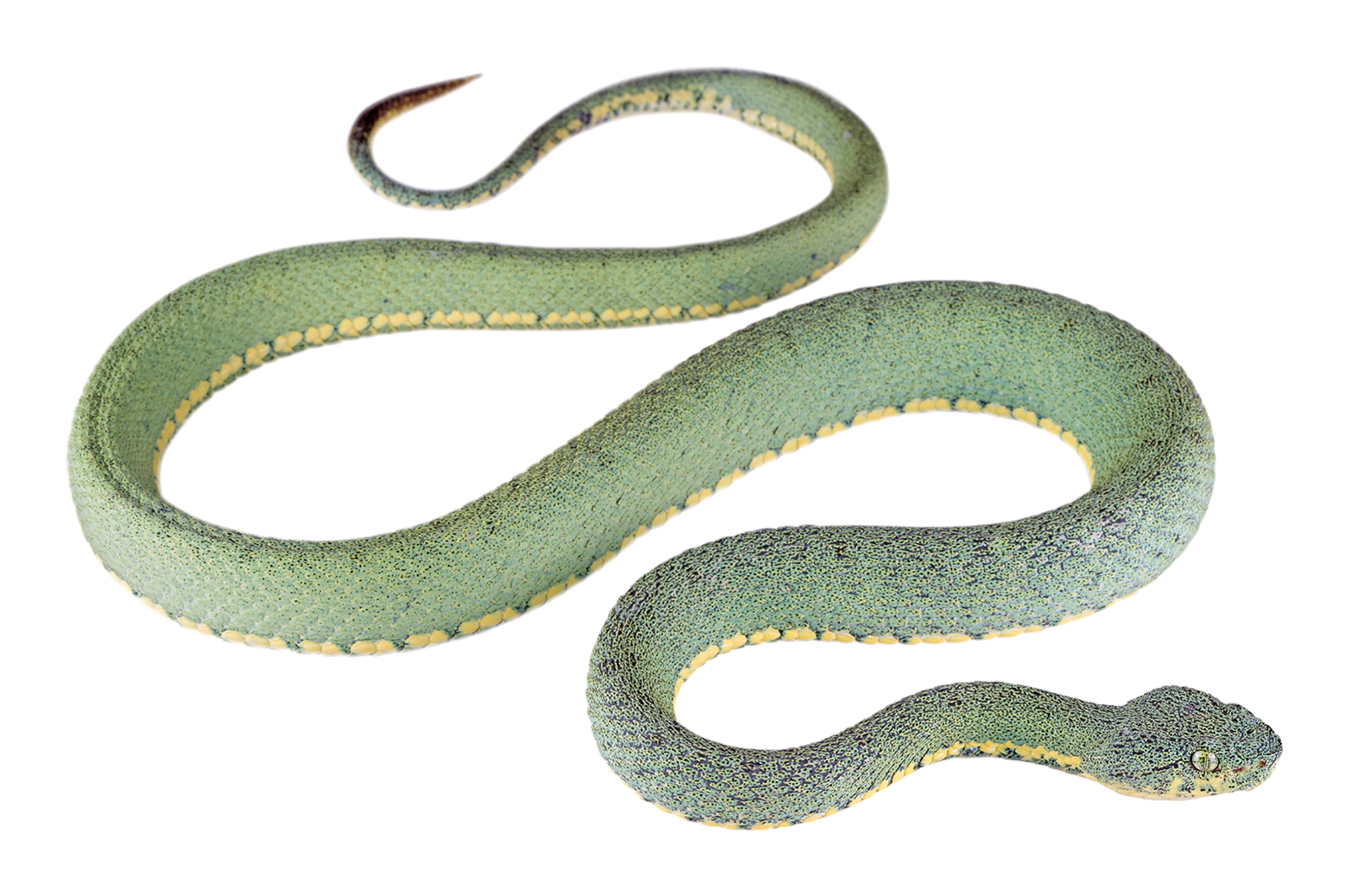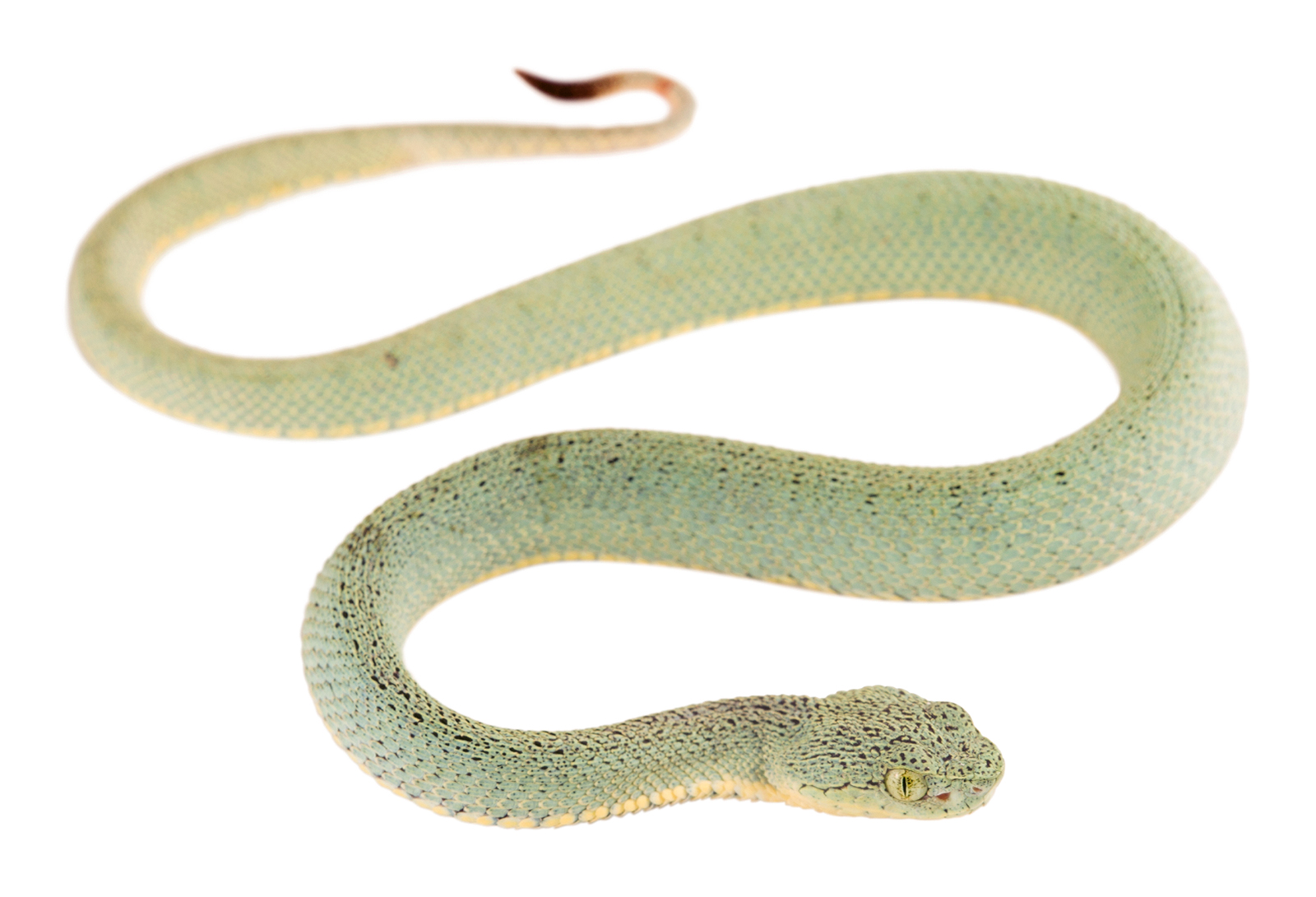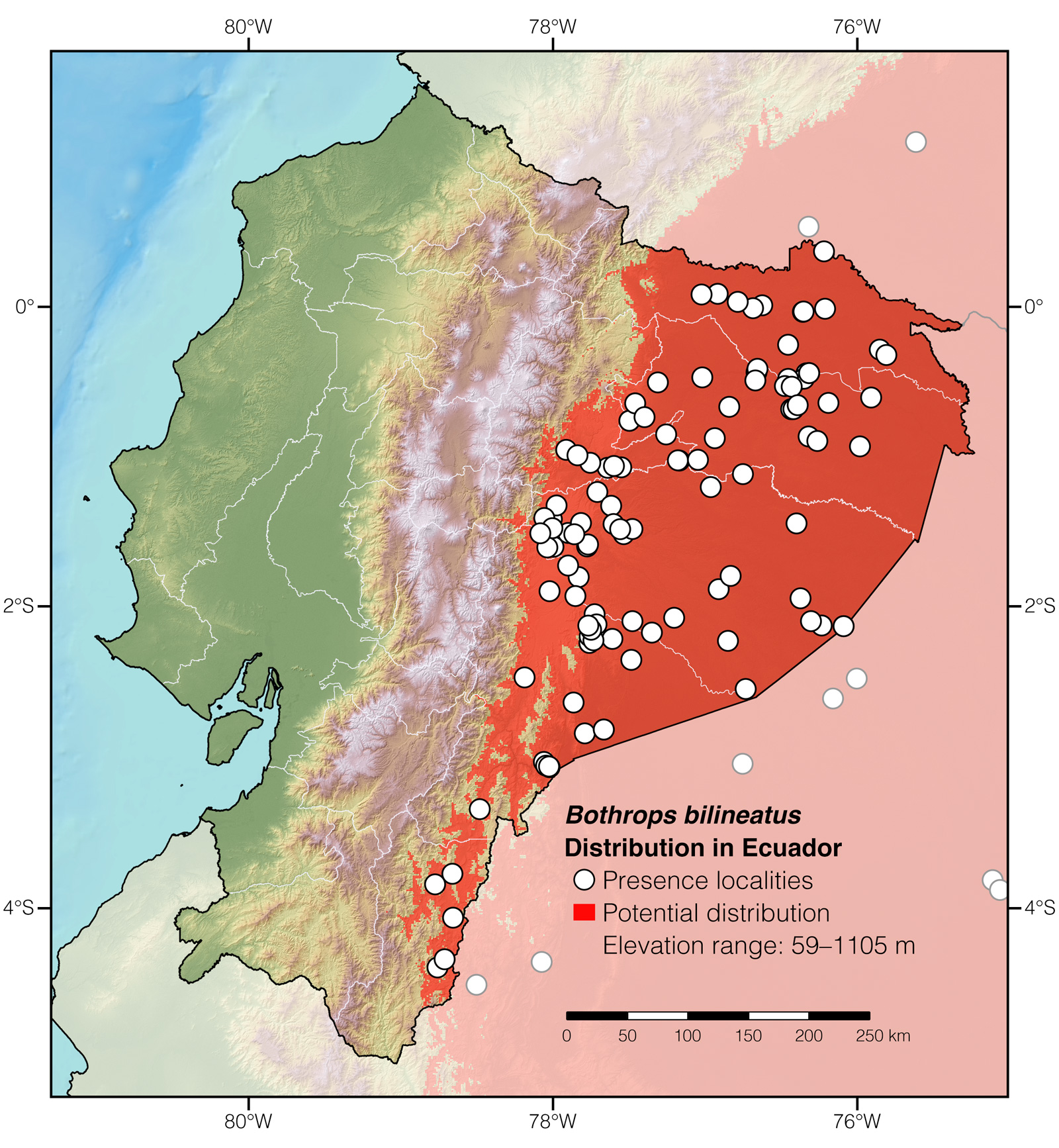Two-lined Forest-Pitviper |
Reptiles of Ecuador | Serpentes | Viperidae | Bothrops bilineatus
English common names: Two-lined Forest-Pitviper, Two-striped Forest-Pitviper, Green Jararaca.
Spanish common names: Lorito, loro, oro palito (Ecuador); víbora loro (Bolivia); loro machaco, loro mashaco, lorito machacui (Peru); mapanare verde, mapanare lora, cuaima lora (Venezuela).
Recognition: ♂♂ 71.9 cmMaximum distance from the snout to the tip of the tail. ♀♀ 112.3 cmMaximum distance from the snout to the tip of the tail.. In its area of distribution, the Two-lined Forest-Pitviper (Bothrops bilineatus) may be recognized by having the following combination of features: triangular-shaped head, heat-sensing pits between the eyes and nostrils, prehensile (capable of grasping) tail, uniformly green dorsum with black specks on each scale, and two (one on each side) yellow longitudinal line along the lower flanks.1,2 The color of the tail-tip contrasts strongly with the dorsum: it can be black, orange-yellow, brown, pink, or whitish. The most similar vipers in Ecuador are B. pulcher and B. taeniatus, both of which have bold dark blotches on the dorsum and lack distinct lateral stripes along the lower flanks.1
Picture: Adult from Yarina Lodge, Napo, Ecuador. | |
 | |
Picture: Juvenile from Yasuní National Park, Orellana, Ecuador. | |
 | |
Natural history: Uncommon. Bothrops bilineatus is an arboreal snake that inhabits old-growth to moderately disturbed evergreen forests, forest borders, cassava plantations, and rural gardens.3,4 Two-lined Forest-Pitvipers usually rest during the day and become active, assuming an ambush position, at night.5 They spend most (up to 90%)6 of their time coiled on vegetation 1–18 m above the ground,4,7 but may also be found coiled at ground level or on fallen tree trunks.3 Juveniles seem to perch on lower strata, whereas the adults prefer higher perches.8 Individuals may remain at the same perch site for days.7
Two-striped Forest-Pitvipers are ambush predators that “bite and hold” their prey.3 Their diet includes treefrogs (Boana boans, Dendropsophus marmoratus, and Osteocephalus taurinus),5,9,10 lizards (Anolis fuscoauratus and Thecadactylus solimoensis),3,10 other snakes,6 mammals (rodents and bats),3,10 and birds.11 Both juveniles and adults attract prey by means of moving their brightly colored tails as a lure.5 Individuals of Bothrops bilineatus obtain water from drops that accumulate on their skin during rains.4
“Snakes in these wilds are certainly an annoyance, though perhaps more in imagination than reality; for you must recollect that the serpent is never the first to offend; his poisonous fang was not given for conquest: he never inflicts a wound with it but to defend existence. Provided you walk cautiously, and do not absolutely touch him, you may pass safely close by him. As he is often coiled up on the ground, and amongst the branches of the trees above you, a degree of circumspection is necessary, lest you unwarily disturb him.”
Charles Waterton, English naturalist and explorer, 1825.12
Two-striped Forest-Pitvipers rely on their camouflage as a primary defense mechanism,3 but may readily bite if attacked or harassed. Bothrops bilineatus is a venomous snake (LD50 8.24 mg/kg)13 that is responsible for 3–36% of snakebites throughout its range.14–16 In humans, its venom causes intense pain, swelling, bruising, bleeding, blistering, fever, loss of consciousness, acute renal injury, and death.14,17,18 Critically envenomated victims presumably die from intracranial hemorrhage or from acute renal failure. Although is not as toxic as other vipers in Ecuador, B. bilineatus is still one of the most dangerous for its arboreal lifestyle, which causes human victims to be bitten on the head, upper body, and hands.14,19 Fortunately, the antivenom available in Ecuador can, to a degree, neutralize the venom of B. bilineatus.16
“I walked within a foot from the snake, and it made an abortive attempt at my face, striking the rim of my hat before I saw it.”
William Beebe, American naturalist and explorer, 1946.9
After a gestation period of at least 191–210 days (~6–7 months),3,20 females of Bothrops bilineatus “give birth” (the eggs hatch within the mother) to 4–16 young that are 20–27 cm in total length.1,21,22 In captivity, individuals can live up to 7 years,3 and probably much longer.
What to do if you are bitten by a Two-lined Forest-Pitviper?
|
Conservation: Least Concern.25 Bothrops bilineatus is listed in this category because the species is widely distributed, especially throughout the Amazon basin, a region that retains most of its original forest cover. Therefore, B. bilineatus is considered to be facing no major immediate extinction threats. We estimate that, in Ecuador, ~87.4% of the habitat of the species holds pristine forest. Unfortunately, the population of B. bilineatus occurring on the Atlantic Forest of Brazil, which is genetically distinct,26 occurs over an area that has lost the majority (84–88.6%) of its forest cover.27
Distribution: Bothrops bilineatus occurs throughout the Amazon basin and adjacent foothills of the Andes in Bolivia, Brazil, Colombia, Ecuador, French Guiana, Guyana, Peru, Suriname, and Venezuela. It also occurs in the Atlantic Forest of Brazil.1 In Ecuador, the species is native to an estimated 96,683 km2 area.

Etymology: The generic name Bothrops, which is derived from the Greek word bothros (meaning “pit”),28 refers to the heat-sensing pits between the eyes and nostrils. The specific epithet bilineatus, which is derived from the Latin words bi- (a prefix meaning “two”) and lineatus (meaning “marked with lines”), refers to the pale stripes on the lower flanks.1
See it in the wild: Two-lined Forest-Pitvipers can be located with ~1–5% certainty in forested areas throughout the species' area of distribution in Ecuador. Some of the best localities to find Two-lined Forest-Pitvipers are Yasuní National Park, Jatun Sacha Biological Reserve, and Shiripuno Lodge. The snakes may be located by walking along trails at night.
Special thanks to Ewald Wasink and Cheryl Vogt for symbolically adopting the Two-lined Forest-Pitviper and helping bring the Reptiles of Ecuador book project to life.
Click here to adopt a species.
Author: Alejandro ArteagaaAffiliation: Fundación Khamai, Reserva Arlequín, Ecoruta Paseo del Quinde km 56, Santa Rosa de Mindo, Pichincha 171202, Ecuador.
Photographers: Jose VieiraaAffiliation: Tropical Herping (TH), Quito, Ecuador.,bAffiliation: ExSitu, Quito, Ecuador. and Sebastián Di Doménico.
How to cite? Arteaga A (2020) Bothrops bilineatus. In: Arteaga A, Bustamante L, Vieira J (Eds) Reptiles of Ecuador: Life in the middle of the world. Available from: www.reptilesofecuador.com
Literature cited:
- Campbell JA, Lamar WW (2004) The venomous reptiles of the western hemisphere. Cornell University Press, Ithaca, 774 pp.
- Harvey MB, Aparicio J, Gonzales L (2009) Revision of the venomous snakes of Bolivia. II. The pitvipers (Serpentes: Viperidae). Annals of the Carnegie Museum 74: 1–37.
- Valencia JH, Garzón-Tello K, Barragán-Paladines ME (2016) Serpientes venenosas del Ecuador: sistemática, taxonomía, historial natural, conservación, envenenamiento y aspectos antropológicos. Fundación Herpetológica Gustavo Orcés, Quito, 653 pp.
- Field notes, Reptiles of Ecuador book project.
- da Fonseca WL, de Souza Oliveira A, Rodrigues Correa R, Bernarde PS (2019) Caudal luring in the Neotropical two-striped forest pitviper Bothrops bilineatus smaragdinus Hoge, 1966 in the western Amazon. Herpetology Notes 12: 365–374.
- Martins M, Marques OAV, Sazima I (2002) Ecological and phylogenetic correlates of feeding habits in Neotropical pitvipers of the genus Bothrops. In: Schuett GW, Höggren M, Douglas ME, Greene HW (Eds) Biology of the vipers. Eagle Mountain Publishing, Eagle Mountain, 307–328.
- Debeux MJM, Leite Silva Vilela HA, Barbosa de Andrade A, Bernarde PS (2019) Bothrops bilineatus bilineatus (Two-striped Forest Pitviper). Habitat use. Herpetological Review 50: 385.
- Touzet JM (1997) Bothriopsis bilineatus smaragdinus: Ecuador’s eye-grabbing emerald. Reptiles 5: 40–46.
- Beebe W (1946) Field notes on the snakes of Kartabo, British Guiana, and Caripito, Venezuela. Zoologica 31: 11–52.
- Venegas PJ, Chávez-Arribasplata JC, Almora García E, Grilli P, Duran Centeno V (2019) New observations on diet of the South American two-striped forest-pitviper Bothrops bilineatus smaragdinus (Hoge, 1966). Cuadernos de Herpetología 33: 29–31.
- Dixon JR, Soini P (1977) The reptiles of the upper Amazon Basin, Iquitos region, Peru. II. Crocodilians, turtles and snakes. Milwaukee Public Museum, Milwaukee, 91 pp.
- Waterton C (1825) Wanderings in South America, the North-west of the United States, and the Antilles in the years 1812, 1816, 1820, and 1824. T. Fellowes, London, 341 pp.
- Unpublished data by Antonio Freire.
- Warrell DA (2004) Snakebites in Central and South America: epidemiology, clinical features, and clinical management. In: Campbell JA, Lamar WW (Eds) The Venomous reptiles of the Western Hemisphere. Cornell University Press, Ithaca, 709–761.
- Silva Haad J (1982) Accidentes humanos por las serpintes de los géneros Bothrops y Lachesis. Memórias do Instituto Butantan 44: 403–423.
- Smalligan R, Cole J, Brito N, Laing GD, Mertz BL, Manock S, Maudlin J, Quist B, Holland G, Nelson S, Lalloo DG, Rivadeneira G, Barragán ME, Dolley D, Eddleston M, Warrell DA, Theakston RDG (2004) Crotaline snake bite in the Ecuadorian Amazon: randomised double blind comparative trial of three South American polyspecific antivenoms. BMJ 329: 1129–1135.
- Porto JM, Telli CA, Dutra TP, Alves LS, Bozza MT, Fin CA, Thiesen FV, Renner MF (2007) Biochemical and biological characterization of the venoms of Bothriopsis bilineata and Bothriopsis taeniata (Serpentes: Viperidae). Toxicon 50: 270–277.
- Torrez PPQ, Said R, Quiroga MMM, Duarte MR, França FOS (2014) Forest pit viper (Bothriopsis bilineata bilineata) bite in the Brazilian Amazon with acute kidney injury and persistent thrombocytopenia. Toxicon 85: 27–30.
- Touzet JM (1986) Mordeduras de ofidios venenosos en la comunidad de los indígenas Siona-Secoya de San Pablo de Kantesyia y datos sobre la fauna de reptiles y anfibios locales. Publicaciones del Museo Ecuatoriano de Ciencias Naturales 7: 163–190.
- Almeida-Santos SM, da Graça Salomão M (2002) Reproduction in neotropical pitvipers, with emphasis on species of the genus Bothrops. In: Schuett GW, Höggren M, Douglas ME, Greene HW (Eds) Biology of the vipers. Eagle Mountain Publishing, Eagle Mountain, 445–462.
- Lima de Almeida BJ, Monteiro de Almeida MS, Cavalcante CS, Bernarde PS (2019) Bothrops bilineatus bilineatus (Two-striped Forest-Pitviper). Reproduction. Herpetological Review 50: 385–386.
- Grego KF, Fernandes W, Croce AP, Vasconcellos DR, Sant'Anna SS (2012) Bothriopsis bilineata smaragdinus (Green Jararaca). Reproduction. Herpetological Review 43: 492.
- Hardy DL (1994) Bothrops asper (Viperidae) snakebite and field researchers in Middle America. Biotropica 26: 198–207.
- Avau B, Borra V, Vandekerckhove P, De Buck E (2016) The treatment of snake bites in a first aid setting: a systematic review. PLoS Neglected Tropical Diseases 10: e0005079.
- Carrillo E, Aldás A, Altamirano M, Ayala F, Cisneros-Heredia DF, Endara A, Márquez C, Morales M, Nogales F, Salvador P, Torres ML, Valencia J, Villamarín F, Yánez-Muñoz M, Zárate P (2005) Lista roja de los reptiles del Ecuador. Fundación Novum Millenium, Quito, 46 pp.
- Dal Vechio F, Prates I, Grazziotin FG, Zaher H, Rodrigues MT (2018) Phylogeography and historical demography of the arboreal pit viper Bothrops bilineatus (Serpentes, Crotalinae) reveal multiple connections between Amazonian and Atlantic rain forests. Journal of Biogeography 45: 2415–2426.
- Ribeiro MC, Metzger JP, Martensen AC, Ponzoni FJ, Hirota MM (2009) The Brazilian Atlantic Forest: how much is left, and how is the remaining forest distributed? Implications for conservation. Biological Conservation 142: 1141–1153.
- Brown RW (1956) Composition of scientific words. Smithsonian Books, Washington D.C., 882 pp.